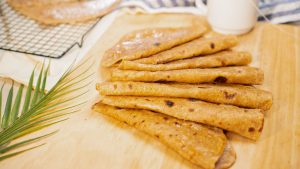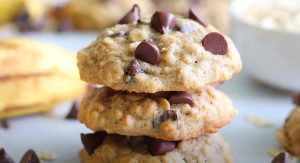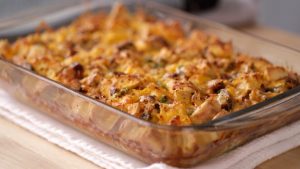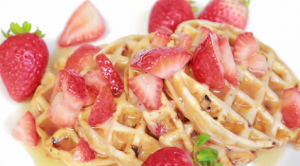Known for its soft, chewy texture, Turkish flatbread, also known as pide, is a staple in Turkish cuisine. It's a versatile bread that can be a base for a variety of dishes or enjoyed simply with dips and spreads. Baking it at home can bring a piece of this rich culinary tradition to your kitchen.
Most ingredients are likely already in your pantry - flour, yeast, sugar, and olive oil. However, you might need to check for active dry yeast which is crucial for the dough to rise and create that distinctive fluffy texture. It's easily found in the baking aisle of any supermarket. Also, make sure you have some good quality olive oil, which adds a subtle yet important flavor to the bread.
Ingredients for Turkish Flatbread
Active dry yeast: This type of yeast needs to be activated before use and helps the dough rise.
White sugar: Feeds the yeast and promotes rising.
All-purpose flour: Creates the structure of the bread.
Lukewarm water: Helps to activate the yeast and hydrate the flour.
Olive oil: Adds a rich flavor to the bread and aids in browning.
Salt: Enhances the flavors in the bread.
Butter: Used to grease the bowl for proofing the dough.
One reader, Emelia Sims says:





This Turkish flatbread recipe is a game-changer! The bread turned out soft and fluffy, with a perfect golden crust. The aroma of freshly baked bread filled my kitchen, and the taste was simply divine. I can't wait to make it again and share it with my friends and family!
Mastering the Techniques for Turkish Flatbread
Dissolve yeast and sugar in warm water: This step is crucial to activate the yeast and ensure proper rising of the dough. It involves stirring the yeast and sugar into warm water and allowing it to stand until frothy.
Knead the dough: Kneading the dough is essential to develop the gluten and create a smooth, elastic texture. This process involves working the dough on a floured surface for about 15 minutes.
Shape each ball of dough into a circle: This step involves flattening and stretching each ball of dough into a circular shape before arranging them on the baking sheets.
Preheat the oven: Preheating the oven to 450 degrees Fahrenheit ensures that the flatbreads bake at the correct temperature, resulting in a golden, puffed-up texture.
How To Make Turkish Flatbread Recipe
Satisfy your cravings for Middle East foods with this Turkish flatbread made with a one-bowl-no-mixer recipe and is perfect with hummus, tabouli, or wraps.
Serves:
Ingredients
For the sponge:
- 8tspactive dry yeast
- 1tspwhite sugar
- 1cupwarm water
- 1cupall-purpose flour
For the dough:
- 7cupsall-purpose flour
- 2cupslukewarm water
- 2tbsplukewarm water
- 6tbspolive oil
- 2tspsalt
- 1tspbutter,or as needed
Instructions
-
Dissolve yeast and sugar in warm water. Let stand in a warm place until frothy for about 10 minutes. Stir in flour. Cover the sponge with plastic wrap and let rise for 30 minutes.
-
Place flour in a large bowl and make a well in the centre. Pour in the sponge.
-
Add lukewarm water, olive oil, and salt. Gradually work in the flour to make a soft and sticky dough.
-
Knead the dough on a floured surface for 15 minutes. Grease a large bowl with butter and add the dough. Cover and let rise until doubled for about an hour.
-
Divide the dough into quarters. Cut each quarter into 10 pieces; shape each piece into a ball. Cover balls of dough and let rest for 30 minutes.
-
Preheat the oven to 450 degrees F. Line baking sheets with parchment paper.
-
Shape each ball of dough into a circle by flattening the dough and stretching it. Arrange 2 inches apart on the baking sheets.
-
Bake in the preheated oven until puffed up and golden for about 10 minutes.
Nutrition
- Calories: 112.76kcal
- Fat: 2.43g
- Saturated Fat: 0.39g
- Trans Fat: 0.00g
- Monounsaturated Fat: 1.56g
- Polyunsaturated Fat: 0.32g
- Carbohydrates: 19.51g
- Fiber: 0.89g
- Sugar: 0.17g
- Protein: 2.91g
- Cholesterol: 0.25mg
- Sodium: 108.28mg
- Calcium: 4.66mg
- Potassium: 34.46mg
- Iron: 1.19mg
- Vitamin A: 0.81µg
- Vitamin C: 0.00mg
Elevate Your Turkish Flatbread with This Technique Tip
When shaping the dough into balls, try to keep them as even in size as possible. This will ensure that they all bake evenly in the oven. If you're having trouble getting them to be the same size, you can use a kitchen scale to weigh each ball of dough. This might seem like an extra step, but it can make a big difference in the final product. Also, when you're flattening and stretching the dough into circles, be gentle to prevent the dough from tearing. If it does tear, simply pinch it back together and continue shaping.
Time-Saving Tips for Turkish Flatbread Recipe
Plan ahead: Prepare the sponge the night before and let it rest in the refrigerator overnight to save time the next day.
Use a stand mixer: Let the stand mixer do the hard work of kneading the dough, saving you time and effort.
Pre-portion the dough: Divide the dough into portions and freeze what you don't need for later use, saving time on future preparations.
Preheat the oven: Always preheat the oven while the dough is resting to save time during the baking process.
Batch cooking: Double the recipe and freeze the extra flatbreads for quick and convenient meals in the future.
Substitute Ingredients For Turkish Flatbread Recipe
active dry yeast - Substitute with instant yeast: Instant yeast can be used as a direct substitute for active dry yeast, but it does not require proofing in warm water before using.
white sugar - Substitute with brown sugar: Brown sugar can add a slightly richer flavor and color to the flatbread.
all-purpose flour - Substitute with bread flour: Bread flour has a higher protein content, which can result in a chewier texture and better structure for the flatbread.
warm water - Substitute with warm milk: Warm milk can add a subtle richness to the flatbread.
olive oil - Substitute with vegetable oil: Vegetable oil can be used as a neutral substitute for olive oil in the dough.
salt - Substitute with kosher salt: Kosher salt has a coarser texture and can enhance the flavor of the flatbread.
butter - Substitute with ghee: Ghee can add a rich, nutty flavor to the flatbread.
Presenting Turkish Flatbread: Tips and Tricks
Artfully arrange the flatbreads: Place the flatbreads on a beautiful serving platter, ensuring they are evenly spaced and visually appealing.
Garnish with fresh herbs: Sprinkle the flatbreads with a generous amount of freshly chopped parsley or mint to add a pop of color and freshness.
Pair with a selection of dips: Serve the flatbreads with an assortment of dips such as hummus, tzatziki, and muhammara in small, elegant bowls for a delightful flavor variety.
Add a touch of elegance with edible flowers: Place a few delicate, edible flowers such as nasturtiums or pansies on the platter for a sophisticated and visually stunning presentation.
Serve on artisanal ceramic plates: Present the flatbreads on handcrafted ceramic plates to elevate the dining experience and showcase the artisanal nature of the dish.
Accompany with a selection of Mediterranean olives: Arrange a small dish of assorted Mediterranean olives alongside the flatbreads to provide a burst of flavor and a touch of sophistication.
Incorporate a variety of textures: Consider serving the flatbreads on a mix of wooden boards and slate platters to create an engaging and visually appealing display.
Enhance with a drizzle of infused olive oil: Just before serving, lightly drizzle the flatbreads with a high-quality infused olive oil to add a luxurious touch and enhance the overall flavor profile.
Present with a selection of exotic spices: Offer a small dish with a mix of sumac, za'atar, and Aleppo pepper for guests to sprinkle over their flatbreads, adding an element of interactive dining.
Serve with a side of grilled vegetables: Accompany the flatbreads with a side of beautifully charred grilled vegetables such as bell peppers, zucchini, and eggplant for a visually stunning and flavorful addition to the dish.
Essential Tools for Making Turkish Flatbread
Mixing bowl: A mixing bowl is essential for combining ingredients and allowing them to rest or rise.
Oven: An oven is necessary for baking the flatbread to perfection.
Baking sheets: Baking sheets are used to place the shaped flatbread dough and bake them in the oven.
Parchment paper: Parchment paper is used to line the baking sheets, preventing the flatbread from sticking and making cleanup easier.
Plastic wrap: Plastic wrap is used to cover the sponge and dough while they rise.
Floured surface: A floured surface is used for kneading and shaping the dough.
Large bowl: A large bowl is used for making the dough and allowing it to rise.
Food processor: A food processor can be used to mix and knead the dough, making the process quicker and easier.
Measuring cups and spoons: Measuring cups and spoons are essential for accurately measuring the ingredients.
Rolling pin: A rolling pin is used to shape and flatten the dough into circles before baking.
Brush: A brush can be used to apply oil or butter to the flatbread before or after baking.
Storing and Freezing Turkish Flatbread for Later
Once the turkish flatbread has cooled completely, wrap each piece tightly in plastic wrap or aluminum foil. This will help prevent the bread from drying out and maintain its soft texture.
Place the wrapped flatbread in an airtight container or resealable plastic bag. This will provide an extra layer of protection against moisture and air, which can cause the bread to become stale.
Store the container or bag of wrapped flatbread at room temperature for up to 3 days. Avoid storing the bread in the refrigerator, as this can cause it to dry out and become stale more quickly.
If you want to keep the turkish flatbread fresh for longer, you can freeze it for up to 2 months. To freeze, wrap each piece tightly in plastic wrap or aluminum foil, then place the wrapped pieces in a freezer-safe container or resealable plastic bag.
When you're ready to enjoy the frozen flatbread, remove the desired number of pieces from the freezer and let them thaw at room temperature for about an hour. You can also reheat the thawed bread in a preheated oven at 350°F (175°C) for 5-10 minutes, or until warmed through and slightly crispy on the outside.
To maintain the best quality and texture of the turkish flatbread, avoid refreezing previously frozen bread. If you don't plan on consuming all of the thawed bread at once, it's best to only remove the amount you need from the freezer and keep the rest frozen until needed.
How to Reheat Leftover Turkish Flatbread
To reheat leftover turkish flatbread, preheat your oven to 350°F (175°C). Wrap the flatbread in aluminum foil and place it on a baking sheet. Bake for 5-10 minutes, or until heated through. This method will help to restore the flatbread's original texture and keep it from drying out.
Another option is to use a toaster oven. Set the toaster oven to 350°F (175°C) and place the flatbread directly on the rack. Toast for 3-5 minutes, or until warmed through and slightly crispy on the outside.
For a quicker reheating method, you can use a microwave. Place the flatbread on a microwave-safe plate and heat it on high power for 15-20 seconds. If the flatbread isn't warm enough, continue heating it in 10-second intervals until it reaches the desired temperature. Be careful not to overheat the flatbread, as it may become tough or rubbery.
If you prefer a crispy texture, you can reheat the flatbread in a skillet or on a griddle. Heat a small amount of olive oil or butter in the skillet over medium heat. Add the flatbread and cook for 1-2 minutes on each side, or until crispy and heated through.
For a softer texture, you can wrap the flatbread in a slightly damp paper towel and microwave it for 15-20 seconds. This method will help to steam the flatbread and restore its original softness.
Fascinating Facts About Turkish Flatbread
The Turkish flatbread recipe is a traditional staple in Turkish cuisine, often served alongside kebabs, dips, and other dishes. It is a versatile bread that can be used for wraps, sandwiches, or simply enjoyed on its own. The process of making this flatbread involves creating a sponge, which helps to develop the flavor and texture of the bread. This method is a common practice in bread-making and is used to enhance the overall quality of the final product. The flatbread is typically cooked at a high temperature, resulting in a puffed-up and golden exterior with a soft and chewy interior.
Turkish Flatbread: An Economical Choice for Home Cooking?
This turkish flatbread recipe is highly cost-effective for households. The main ingredients like flour, yeast, and olive oil are affordable and readily available. The recipe yields a large quantity, making it suitable for a family of four. The approximate cost for a household of four people is around $5, making it a budget-friendly option. The versatility of this flatbread also adds value, as it can be paired with various dishes. Overall Verdict: 9/10
Is Turkish Flatbread Healthy or Unhealthy?
The Turkish flatbread recipe, while delicious, is not particularly healthy due to its high content of refined all-purpose flour and the use of olive oil. Here's a breakdown of the recipe's nutritional aspects:
- All-purpose flour: This type of flour is refined and lacks the beneficial nutrients and fiber found in whole grain flours.
- Olive oil: Although olive oil is a healthier fat compared to other oils, it still contributes to the overall calorie count of the recipe.
- High carbohydrate content: The recipe is predominantly made up of flour, which means it is high in carbohydrates and may not be suitable for those following a low-carb diet.
- Lack of fiber: Due to the use of all-purpose flour, the flatbread may not provide a significant amount of dietary fiber, which is essential for digestive health and satiety.
To make this recipe healthier, consider the following suggestions:
- Substitute at least half of the all-purpose flour with whole wheat flour or other whole grain flours like spelt, rye, or oat flour. This will increase the fiber content and provide additional nutrients.
- Reduce the amount of olive oil used in the recipe or consider using a healthier alternative like avocado oil, which has a higher smoke point and is rich in monounsaturated fats.
- Incorporate additional ingredients to boost the nutritional value, such as:
- Flaxseed meal or chia seeds for added fiber and omega-3 fatty acids
- Herbs and spices like garlic powder, onion powder, or dried herbs for flavor without increasing calorie content
- Finely grated vegetables like zucchini or carrots for added moisture and nutrients
- Serve the flatbread with nutrient-dense toppings like hummus, tzatziki, or fresh vegetables to create a more balanced and wholesome meal.
Editor's Take on This Delightful Turkish Flatbread
This Turkish flatbread recipe offers a delightful balance of simplicity and flavor. The sponge method provides a lovely depth of taste, while the addition of olive oil lends a subtle richness. The dough's texture is beautifully soft and pliable, resulting in a perfect flatbread. The baking process yields a golden, puffed result that is both visually appealing and delicious. Overall, this recipe promises a delightful culinary experience and is sure to impress with its authentic Turkish flavors.
Enhance Your Turkish Flatbread Recipe with These Unique Side Dishes:
Exploring Recipes Similar to Turkish Flatbread
Appetizers and Desserts to Complement Turkish Flatbread
Why trust this Turkish Flatbread Recipe:
This recipe for Turkish flatbread is a tried and tested favorite, crafted with care and expertise. The yeast sponge ensures a light and airy texture, while the addition of olive oil infuses a delightful flavor. The use of warm water at various stages guarantees optimal dough consistency. With meticulous attention to detail, this recipe promises authentic Turkish flatbread that's perfect for any occasion. Trust in the combination of traditional techniques and quality ingredients, including all-purpose flour and butter, to deliver a delectable result every time.
Was this page helpful?
Have your own special recipe to share? Submit Your Recipe Today!















